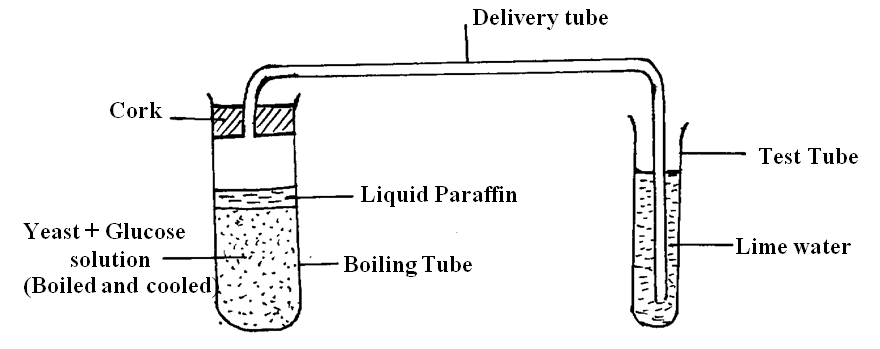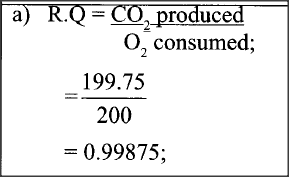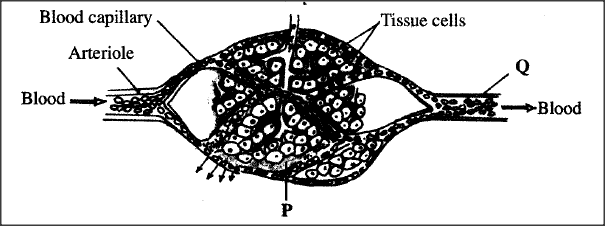(a) Which process was being investigated? (1mk)
Anaerobic respiration
Rej: Respiration alone (b) Why was it necessary to boil the glucose solution? (1mk)
To expel all the dissolved oxygen;
(c) Write a word equation representing the chemical reaction taking place above in the boiling tube (1mk)
0 Comments
The table below show the percentage composition of carbon (IV) oxide and oxygen inhales and exhales air.(a) Explain the differences in the percentage of the two gases in inhaled and exhaled air (2mks)O2 is used by body cells for respiration (b) Carbon (IV) oxide (2mks)CO2 is released by body cells during respiration Insect’s blood is noted to lack a respiratory pigment. Explain (1mk)Insects blood is not used for transportation of respiratory gases
K.C.S.E Biology Q & A - MODEL 2019PP2QN08
Explain the effect of increased physical activity on the following organ systems:
(a) heart (b) lungs (c) kidneys (d) skin.
answers
(a) Heart
-Increased heart beat/ rate/cardiac frequency; increase blood pressure; pumping more blood to the muscles/Peripheral blood vessels; at a faster rates; supplying oxygen; Nutrients; for continued oxidation/respiration; to yield energy needed to sustain the (vigorous) contraction/relaxation of muscles during the physical activity; carbon (iv) oxide /Lactic acid/other Nitrogenous wastes/Metabolic wastes produced during the process are also eliminated/ transported to the relevant excretory organs for elimination; the wastes ,if left to accumulate Can also intoxicate/poison cells/cause muscle cramps/pain/fatigue; (b) Lungs -Panting /increased breathing rates; cause the lungs to expand/increase in volume to take in more air/oxygen; and deflate to expel more carbon (iv) oxide; more oxygen is taken in (during exercise) to sustain the process of muscle respiration/to produce the required energy (for constant muscle contraction and relaxation);
Kidneys also maintain the blood plasma pH; and osmotic balance; by elimination excess hydrogen ions(H+) that accumulate to production of Lactic acid/CO2 during the exercise; To maintain the osmotic balance kidneys conserve sodium ions (Na+); and reabsorb water (in the kidney tubules); Leading to reduction in the volume of urine produced; During exercise the kidney tend to filter out urine releasing more in the urine; (d) Skin - Due to increased muscle activity during physical exercise are sweats(more); Eliminating Nitrogenous wastes/ excess water; through the skin/sweat pores) cooling the body; After (water in) sweat evaporates the increased internal body temperature also leads to dilation of superficial blood vessels (vasodilation)/ blood flowing near the skin; leading to loss of excess heat (to the atmosphere) by radiation/ convection; the hair on the skin surface also lie Flat to allow for loss of heat( to the environment) by radiation/convection; K.C.S.E Biology Q & A - MODEL 2019PP1QN09
Below is a photograph of Brassica oleracea, Sukuma wiki leaf.
(a)State two observable features that adapt the leaf to gaseous exchange.
(b) Explain the relationship between photosynthesis and aerobic respiration within the leaf.
answers
.(a) broad leaf blade /lamina; that expose more stomata for gaseous exchange; acc broad leaf alone
(b) photosynthesis (within the leaf in the presence of light energy) yield simple carbohydrates /glucose /sugars which form the main substrate during aerobic respiration (producing energy (ATP) During the process of respiration carbon iv oxide produced is intern used as a raw material in photosynthesis; During photosynthesis water is broken down yielding oxygen which is needed/ used in (cellular) (aerobic respiration); K.C.S.E Biology Q & A - MODEL 2019PP1QN06
(a) Name the respiratory structure in the amoeba.
(b) Give a reason for your answer in (a) above.
answers
(a) cell membrane/plasma membrane /plasmalemma;
(b) has a large surface area to volume ratio
K.C.S.E Biology Q & A - MODEL 2018PP1QN10
Name two products of respiration in plants.
ANSWERS
K.C.S.E Biology Q & A - MODEL 2018PP1QN07
State three activities in the human digestive System that depend on respiration.
answers
K.C.S.E Biology Q & A - MODEL 2018PP1QN07
Define respiration
answers
K.C.S.E Biology Q & A - MODEL 2017PP1QN08
Explain why short distance runners breathe quickly and deeply at the end of a race.
answers
K.C.S.E Biology Q & A - MODEL 2017PP1QN04
In an experiment on respiration, a mouse was observed to have inhaled 200 cm3 of oxygen and exhaled 199.75 cm3 of carbon(IV) oxide in ten minutes.
(a) Calculate the respiratory quotient for the activity in the experiment.
(b) Identify the possible food substance consumed by the mouse. (c) State the fate of the excess food named in (b) above in the human body.
K.C.S.E Biology Q & A - MODEL 2016PP1QN14
Give three factors that determine the amount of energy a human being requires in a day.
answers
K.C.S.E Biology Q & A - MODEL 2016PP1QN05
State the economic importance of anaerobic respiration in plants.
answers
K.C.S.E Biology Q & A - MODEL 2015PP1QN09
The diagram below shows an experimental set up to investigate a certain physiological process in plants.
(a) State the aim of the experiment.
(b) State the role of the following in the experiment: (i) potassium hydroxide; (ii) aluminum foil. (c) Account for the expected colour change in tube F.
answers
(a) To show that carbon (TV) oxide is produced during respiration in plants;
(b) (i) Absorb carbon (IV) oxide from the (incoming) air; (ii) Exclude light / to prevent photosynthesis; (c) No colour change in tube F / no observable colour change. Carbon (IV) oxide removed/absorbed from air by potassium hydroxide.
K.C.S.E Biology Q & A - MODEL 2013PP1QN15
State two reasons why accumulation of lactic acid leads to an increase in heart beat.
answers
K.C.S.E Biology Q & A - MODEL 2013PP1QN14
Name the three end products of anaerobic respiration in plants.
answers
K.C.S.E Biology Q & A - MODEL 2012PP1QN14
Name the type of respiration that is most efficient.
b) Give a reason for your answer in (a) above
answer
a)Aerobic respiration;
b)It releases more energy per unit mass;
K.C.S.E Biology Q & A - MODEL 2011PP1QN19
Write an equation that sum manses the process of aerobic respiration.
answers
Glucose + Oxygen (enzyme)=Carbon IV oxide + water + energy;
C6 H12 06+602 (enzyme)= 6C02+6H20 + ATP
K.C.S.E Biology Q & A - MODEL 2011PP1QN10
Name the site of anaerobic respiration in a cell.
answer
K.C.S.E Biology Q & A - MODEL 2011PP1QN10
Give two differences in the products of anaerobic respiration between plants and animals.
answers
(i) Lactic acid in animals while in plants it is ethanol/alcohol;
(ii) No carbon IV oxide produced in anaerobic respiration in animals while anaerobic respiration in plants produces carbon IV oxide; K.C.S.E Biology Q & A - MODEL 2010PP2QN02
The diagram below shows blood circulation in a mammalian tissue.
(a) Name the parts labelled P and Q.
P . Q . (b) Name the substances that are: (i) required for respiration that move out of capillaries; (ii) removed from tissue cells as a result of respiration. (e) Explain how substances move from blood capillaries into the tissue cells. (d) Name one component of the blood that is not found in the part labelled P.
answers
(a)
P Tissue fluid/intercellular/interstitial fluid/space; Q Venule; (b) (i) Glucose, oxygen; (ii) Carbon (iv) Oxide, water; (c) Blood entering arteriole has a high pressure; the pressure forces water and small solute molecules in blood to go through capillary wall forming tissue fluids; nutrients/oxygen more into the tissue cells by diffusion; (d) Red Blood cells/proteins/platelets;
K.C.S.E Biology Q & A - MODEL 2009PP1QN27
State two ways in which anaerobic respiration is applied in industries
answers
K.C.S.E Biology Q & A - MODEL 2009PP1QN24
Explain how the following factors determine the daily energy requirement in human:
(a) Age (b) Occupation (c) Sex
answers
(a) Young people are actively/ rapidly growing hence require more energy than older people
(b) Manual workers require more energy than secretary workers (c)Males are more muscular hence require more energy than females
K.C.S.E Biology Q & A - MODEL 2008PP1QN27
Explain how anaerobic respiration is applied in sewage treatment.
answers
K.C.S.E Biology Q & A - MODEL 2008PP1QN15
Explain what happens when there is oxygen debt in human muscles
ANSWER
|
Archives
December 2024
Categories
All
TOPICSFORM 1
Form 2
Form 3
Form 4
|
Can't find what you are looking for? Don't worry, Use the Search Box Below.
|
Primary Resources
College Resources
|
Secondary Resources
|
Contact Us
Manyam Franchise
P.O Box 1189 - 40200 Kisii Tel: 0728 450 424 Tel: 0738 619 279 E-mail - sales@manyamfranchise.com |
















 RSS Feed
RSS Feed

